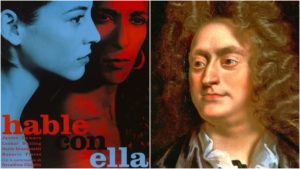
Opera Meets Film: How Pedro Almodovar Establishes Theme in ‘Talk To Her’ Through Henry Purcell’s ‘O, Let Me Forever Weep’
By David SalazarThe first image we see in Pedro Almodovar’s “Talk to Her” is a pair of women on stage, their eyes closed. They walk about the stage as if sleepwalking. A sad man walks around them, moving chairs out of their way so as to avoid them bumping into them and falling over them. Underscoring this action is “O, Let me forever weep” from Henry Purcell’s “The Fairy Queen.”
The text of that aria relates the loss of love and the need to weep forever, sadness transcending death a major theme of “Talk to Her.”
The choice of the aria is essential on a number of levels in this particular context. The text sets up the audience for the film’s cycle of loss and tragedy. Even from the start of the film we see two of our main characters Benigno and Marcos sitting in the theater, the latter weeping with the performance. From there on out both men endure one hardship after another, losing the women they love and ultimately losing their friendship. While “Talk to Her” ends on a positive note, it doesn’t do so without putting the audience on an emotional roller coaster that is filled with pain and suffering.
But the music does more than foreshadow the tone of the film – it gives the opening visuals their meaning. Without the music’s sighing and weeping, the women onstage, in shades of grey, might come off as a nightmarish sequence that could be off-putting to the viewer. With the addition of the music, we are immediately given an emotional cue. It’s a simply technique and a seemingly obvious one, but also an exemplary use of how music can inform the visuals for the audience. When Almodovar cuts to Marcos, we expect the sadness to come over him because the music is guiding the emotions.
The choice of opera operates on a different, perhaps deeper level. It is lost on no one that opera is a performing art and it is this very artifice of performance that plays a crucial role throughout the film. The characters themselves are often “performing” (Alicia is a dancer and Lydia is a bullfighter) or projecting artistic ideals onto one another and creating stories about one another that don’t really exist. Fusing a number of performing arts from the very opening moments of the film, allows Almodovar to really establish this theme of artifice and performance.
That’s how you start a movie.


